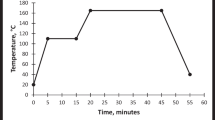Abstract
Denitrification of nitrate in groundwater using iron nanoparticles has received increasing interest in recent years. In order to fabricate iron nanoparticles with homogeneously spherical shape and narrow size distribution, a simple and “green” method was developed to synthesize iron nanoparticles. The conventional microemulsion methods were modified by applying Span 80 and Tween 60 as mixed surfactants. The maximum content of water in the Water-in-oil (W/O) microemulsion and its appropriate forming conditions were found, and then the microemulsion system consisting of saturated Fe2+ solution was used to synthesize α-Fe ultrafine particles by redox reaction. The nanoparticles were characterized by using powder X-ray diffraction (XRD) and transmission electron microscopy (TEM). The results show that the average diameter of the particle is about 80–90 nm. The chemical activity of the obtained iron nanoparticles was studied by the denitrification experiment of nitrate. The results show that under the experimental conditions, iron removed most of the 80 mg/L nitrate within 30 min. The mass balance of nitrate reduction with nanoscale Fe indicates that endproducts are mainly ammonia. Two possible reaction pathways for nitrate reduction by nanoscale iron particles have been proposed in this work.
Similar content being viewed by others
References
Zhang C P, Deng W, Hu Z C, Luo Y P, Gao X, Hu L. Preparation of ultrafine Fe particles by microemulsion method. Chinese Journal of Applied Chemistry, 2000, 17(3): 248–251 (in Chinese)
Deng Y H, Wang L, Yang W L, Fu S K, Abdelhamid E. Synthesis of 30–100 nm nanoscale magnetic polymer particles in inverse microemulsion. Chemical Journal of Chinese Universities, 2003, 24(5): 920–923 (in Chinese)
Zhang S X, Zhang C P, Gou H, Luo Y P, Liu J, Shen D J. Preparation of gelatin-nickel-iron composite nanoparticles with gel-microemulsion chemical tailoring (II) effect of relevant parameters on the composition and size of particles and magnetic properties. Chinese Journal of Rare Metals, 2003, 27(4): 429–433 (in Chinese)
Zhang W X. Nanoscale iron particles for environmental remediation: An overview. Journal of Nanoparticle Research, 2003, 5(3–4): 323–332
Li F, Vipulanandan C, Mohanty K K. Microemulsion and solution approaches to nanoparticle iron production for degradation of trichloroethylene. Colloids and Surfaces A: Physicochemical and Engineering Aspects, 2003, 223: 103–112
Wang C B, Zhang W X. Synthesizing nanoscale iron particles for rapid and complete dechlorination of TCE and PCBs. Environmental Science & Technology, 1997, 31(7): 2154–2156
Lien H L, Zhang W X. Nanoscale iron particles for complete reduction of chlorinated ethenes. Colloids and Surface A: Physicochemical and Engineering Aspects, 2001, 191: 97–105
Kanel S R, Greneche J M. Choi H. Arsenic (V) removal from groundwater using nanoscale zero-valent iron as a colloidal reactive barrier material. Environmental Science & Technology, 2006, 40(6): 2045–2050
Ponder S M, Darab J, Mallouk T E. Remediation of Cr(VI) and Pb(II) aqueous solutions using supported nanoscale zerovalent iron. Environmental Science & Technology, 2000, 34(12): 2564–2569
Chen L W, Gan L H, Yue T Y. Studies on the preparation of aluminium oxide (hydrous) ultrafine particles by the method of microemulsion reaction. Chemical Journal of Chinese Universities, 1995, 16(1): 13–16 (in Chinese)
Andrey J Z, Jackie Y Y. Reverse microemulsion synthesis of nanostructured complex oxides for catalytic combustion. Nature, 2000, 403(6): 65–68
Chiang C L, Hsu M B, Lai L B. Controlled of nucleation and growth of gold nanoparticles in AOT/Span 80/isooctane mixed reverse micelles. Journal of Solid State Chemistry, 2004, 177: 3891–3895
Wang C Y, Jiang W Q, Zhou Y, Wang Y N, Chen Z Y. Synthesis of α-Fe ultrafine particles in a saturated salt solution/isopropanol/PVP microemulsion and their structural characterization. Materials Research Bulletin, 2000, 35: 53–58
Lien H L, Zhang W X. Nanoscale iron particles for complete reduction of chlorinated ethenes. Colloids and Surfaces A: Physicochemical and Engineering Aspects, 2001, 191(1): 97–105
American Public Health Association (APHA), American Water Works Association (AWWA), World Economic Forum (WEF). Standard Methods for the Examination of Water and Wastewater. 20th ed. Washington D C, USA: American Public Health Association, 1999
Li Q, Li Y, Li W H, Weng S F, Wu J G, Xu G X. FT-IR study of water structure in water/NaDEHP/n-heptane microemulsion system. Journal of Peking University (Natural Science), 1997, 33(4): 410–415 (in Chinese)
Author information
Authors and Affiliations
Corresponding author
Additional information
__________
Translated from Chemical Journal of Chinese Universities, 2006, 27(4): 672–675 [译自: 高等学校化学学报]
Rights and permissions
About this article
Cite this article
Zhang, Y., Li, T., Jin, Z. et al. Synthesis of nanoiron by microemulsion with Span/Tween as mixed surfactants for reduction of nitrate in water. Front. Environ. Sci. Eng. China 1, 466–470 (2007). https://doi.org/10.1007/s11783-007-0074-5
Issue Date:
DOI: https://doi.org/10.1007/s11783-007-0074-5




